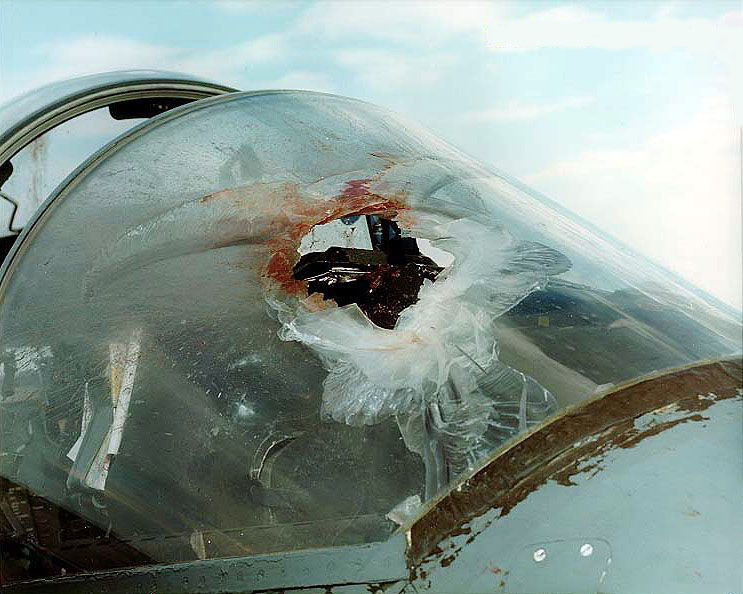What a sad story.
When gliding in the Alps (out of Gap Tallard), several years ago, I found them amazing. One descended to fly along side about a wing span’s distance to check us out, beady eyes meeting mine. They soar beautifully, amazingly elegant birds. I would have thought they would manage to stay out of someone’s way. Maybe the plane was approaching a nesting area?
They have a wingspan of 2.5m and an empty weight of more 8 kilos
Should that break off the wing from a Cessna?
Can one minimise this risk by flying above a certain altitude?
NeilC wrote:
an empty weight of more 8 kilos
And what is their useful load? 
Peter wrote:
Should that break off the wing from a Cessna?
You have to take into account the relative velocity and rather small impact area. There is a photo around of a horizontal stabilizer of US Navy’s King Air after a bird strike. Not sure how real they were, but I heard of several cases where a bird (or what was left of it) entered a cockpit via an instrument panel. That’s some serious force.
I don’t know what the situation is today, but I remember FAA commenting on that King Air incident by saying that they focused during certification on windshields when it came to bird strikes in the past, the stabilizer was exposed and the spar had a single point of failure. Given how old the 172 is, how light it is…
But a C172 survived colliding with a C150: http://www.avweb.com/news/news/184314-1.html
I have to imagine there’s more to the story.
Martin wrote:
I heard of several cases where a bird (or what was left of it) entered a cockpit via an instrument panel
Don’t know about instrument panels, but a bird breaking through the windscreen seems to be fairly common even with military aircraft.
Eg. an Austrian PC-7 trainer in 2014…

…or this pic of a Harrier.

Peter wrote:
Can one minimise this risk by flying above a certain altitude?
They are soaring birds so I would imagine the same way as gliders can be avoided.
On nice days, fly above the clouds or the inversion. If you can’t go above, avoid the clouds. Especially don’t cruise under a cloud street, side step to cruise in the blue.
Avoid the upwind side of slopes.
blueline wrote:
Don’t know about instrument panels, but a bird breaking through the windscreen seems to be fairly common even with military aircraft.
Yep, those seem more common. I remember one story where the bird survived the trip through the windscreen, came to after a while and attacked the pilot.  I think it was a military helicopter. Again, not sure how much I believe it. But it’s an interesting image (the other crew member reportedly had to kill the bird).
I think it was a military helicopter. Again, not sure how much I believe it. But it’s an interesting image (the other crew member reportedly had to kill the bird).
I think there was a bird strike even at something like FL180. I assume those are rare. But then we’re talking about higher speeds so the damage could be substantial.
Xtophe wrote:
Avoid the upwind side of slopes.
And they could be in a wave on the downwind side.
Martin wrote:
I think there was a bird strike even at something like FL180. I assume those are rare. But then we’re talking about higher speeds so the damage could be substantial.
A Swedish airliner had a bird strike in cruise somewhere around FL200 many years ago. The bird struck the nose of the aircraft close the the top edge of the windshield, the windshield broke and the bird carcass ripped out any number of electric wires from the overhead panel. The immediate problem for the flight crew was that they couldn’t talk to each other because of the wind noise…
The accident investigation report was interesting reading.
This list makes sober reading.
https://en.wikipedia.org/wiki/List_of_birds_by_flight_heights
According to that article, the Ruepell vulture can fly right up to the airliner altitudes of 37’000 ft. Don’t know how the heck they breathe up there, but as I have said before, it is not unknown at all to have one of those animals ruin your day over Spain.
Most of the high flying birds are massive. Clearly, the vulture with up to 14 kgs weight (wonder why they don’t have flight suregons nagging at them for their BMI if their usual weight is 8 kgs) is therefore a very destructive force which can easily bring down a plane.